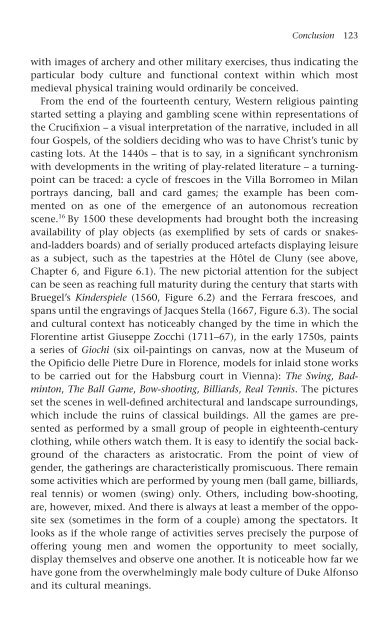Recreation in the Renaissance
Recreation in the Renaissance
Recreation in the Renaissance
- No tags were found...
You also want an ePaper? Increase the reach of your titles
YUMPU automatically turns print PDFs into web optimized ePapers that Google loves.
Conclusion 123<br />
with images of archery and o<strong>the</strong>r military exercises, thus <strong>in</strong>dicat<strong>in</strong>g <strong>the</strong><br />
particular body culture and functional context with<strong>in</strong> which most<br />
medieval physical tra<strong>in</strong><strong>in</strong>g would ord<strong>in</strong>arily be conceived.<br />
From <strong>the</strong> end of <strong>the</strong> fourteenth century, Western religious pa<strong>in</strong>t<strong>in</strong>g<br />
started sett<strong>in</strong>g a play<strong>in</strong>g and gambl<strong>in</strong>g scene with<strong>in</strong> representations of<br />
<strong>the</strong> Crucifixion – a visual <strong>in</strong>terpretation of <strong>the</strong> narrative, <strong>in</strong>cluded <strong>in</strong> all<br />
four Gospels, of <strong>the</strong> soldiers decid<strong>in</strong>g who was to have Christ’s tunic by<br />
cast<strong>in</strong>g lots. At <strong>the</strong> 1440s – that is to say, <strong>in</strong> a significant synchronism<br />
with developments <strong>in</strong> <strong>the</strong> writ<strong>in</strong>g of play-related literature – a turn<strong>in</strong>gpo<strong>in</strong>t<br />
can be traced: a cycle of frescoes <strong>in</strong> <strong>the</strong> Villa Borromeo <strong>in</strong> Milan<br />
portrays danc<strong>in</strong>g, ball and card games; <strong>the</strong> example has been commented<br />
on as one of <strong>the</strong> emergence of an autonomous recreation<br />
scene. 16 By 1500 <strong>the</strong>se developments had brought both <strong>the</strong> <strong>in</strong>creas<strong>in</strong>g<br />
availability of play objects (as exemplified by sets of cards or snakesand-ladders<br />
boards) and of serially produced artefacts display<strong>in</strong>g leisure<br />
as a subject, such as <strong>the</strong> tapestries at <strong>the</strong> Hôtel de Cluny (see above,<br />
Chapter 6, and Figure 6.1). The new pictorial attention for <strong>the</strong> subject<br />
can be seen as reach<strong>in</strong>g full maturity dur<strong>in</strong>g <strong>the</strong> century that starts with<br />
Bruegel’s K<strong>in</strong>derspiele (1560, Figure 6.2) and <strong>the</strong> Ferrara frescoes, and<br />
spans until <strong>the</strong> engrav<strong>in</strong>gs of Jacques Stella (1667, Figure 6.3). The social<br />
and cultural context has noticeably changed by <strong>the</strong> time <strong>in</strong> which <strong>the</strong><br />
Florent<strong>in</strong>e artist Giuseppe Zocchi (1711–67), <strong>in</strong> <strong>the</strong> early 1750s, pa<strong>in</strong>ts<br />
a series of Giochi (six oil-pa<strong>in</strong>t<strong>in</strong>gs on canvas, now at <strong>the</strong> Museum of<br />
<strong>the</strong> Opificio delle Pietre Dure <strong>in</strong> Florence, models for <strong>in</strong>laid stone works<br />
to be carried out for <strong>the</strong> Habsburg court <strong>in</strong> Vienna): The Sw<strong>in</strong>g, Badm<strong>in</strong>ton,<br />
The Ball Game, Bow-shoot<strong>in</strong>g, Billiards, Real Tennis. The pictures<br />
set <strong>the</strong> scenes <strong>in</strong> well-def<strong>in</strong>ed architectural and landscape surround<strong>in</strong>gs,<br />
which <strong>in</strong>clude <strong>the</strong> ru<strong>in</strong>s of classical build<strong>in</strong>gs. All <strong>the</strong> games are presented<br />
as performed by a small group of people <strong>in</strong> eighteenth-century<br />
cloth<strong>in</strong>g, while o<strong>the</strong>rs watch <strong>the</strong>m. It is easy to identify <strong>the</strong> social background<br />
of <strong>the</strong> characters as aristocratic. From <strong>the</strong> po<strong>in</strong>t of view of<br />
gender, <strong>the</strong> ga<strong>the</strong>r<strong>in</strong>gs are characteristically promiscuous. There rema<strong>in</strong><br />
some activities which are performed by young men (ball game, billiards,<br />
real tennis) or women (sw<strong>in</strong>g) only. O<strong>the</strong>rs, <strong>in</strong>clud<strong>in</strong>g bow-shoot<strong>in</strong>g,<br />
are, however, mixed. And <strong>the</strong>re is always at least a member of <strong>the</strong> opposite<br />
sex (sometimes <strong>in</strong> <strong>the</strong> form of a couple) among <strong>the</strong> spectators. It<br />
looks as if <strong>the</strong> whole range of activities serves precisely <strong>the</strong> purpose of<br />
offer<strong>in</strong>g young men and women <strong>the</strong> opportunity to meet socially,<br />
display <strong>the</strong>mselves and observe one ano<strong>the</strong>r. It is noticeable how far we<br />
have gone from <strong>the</strong> overwhelm<strong>in</strong>gly male body culture of Duke Alfonso<br />
and its cultural mean<strong>in</strong>gs.










